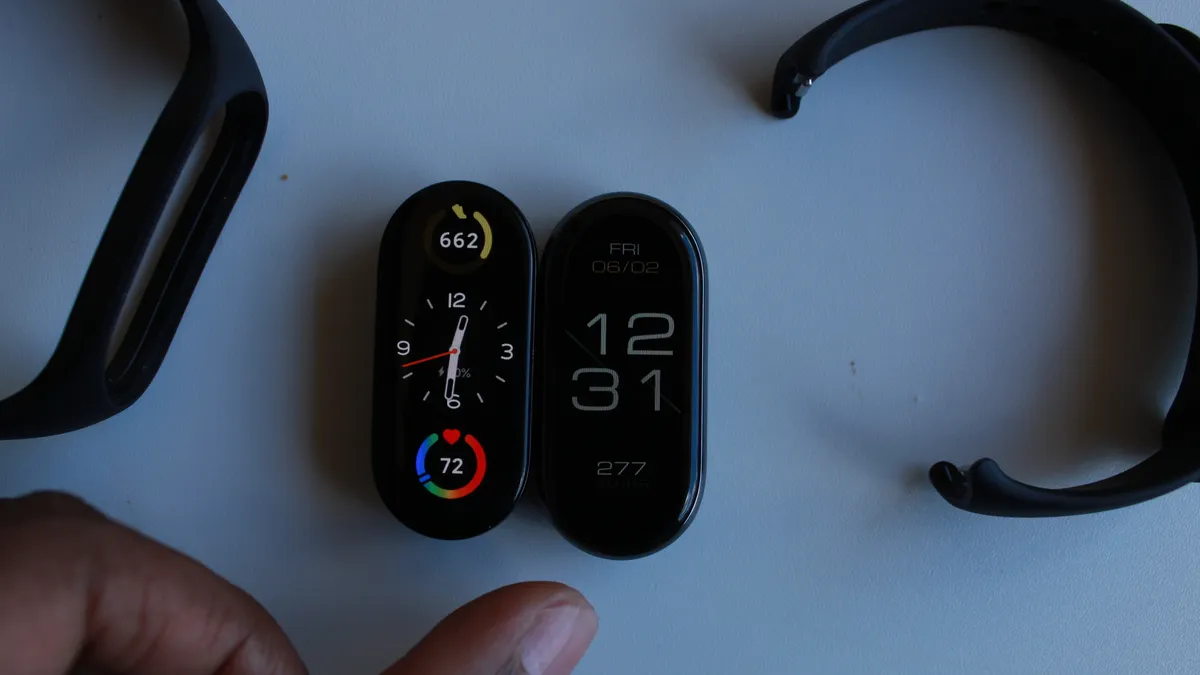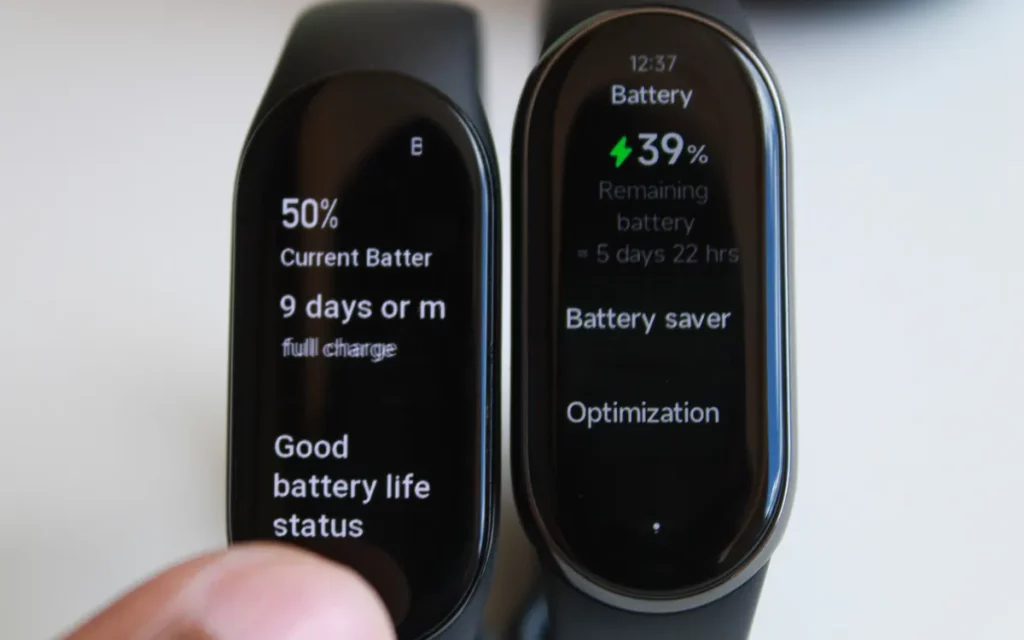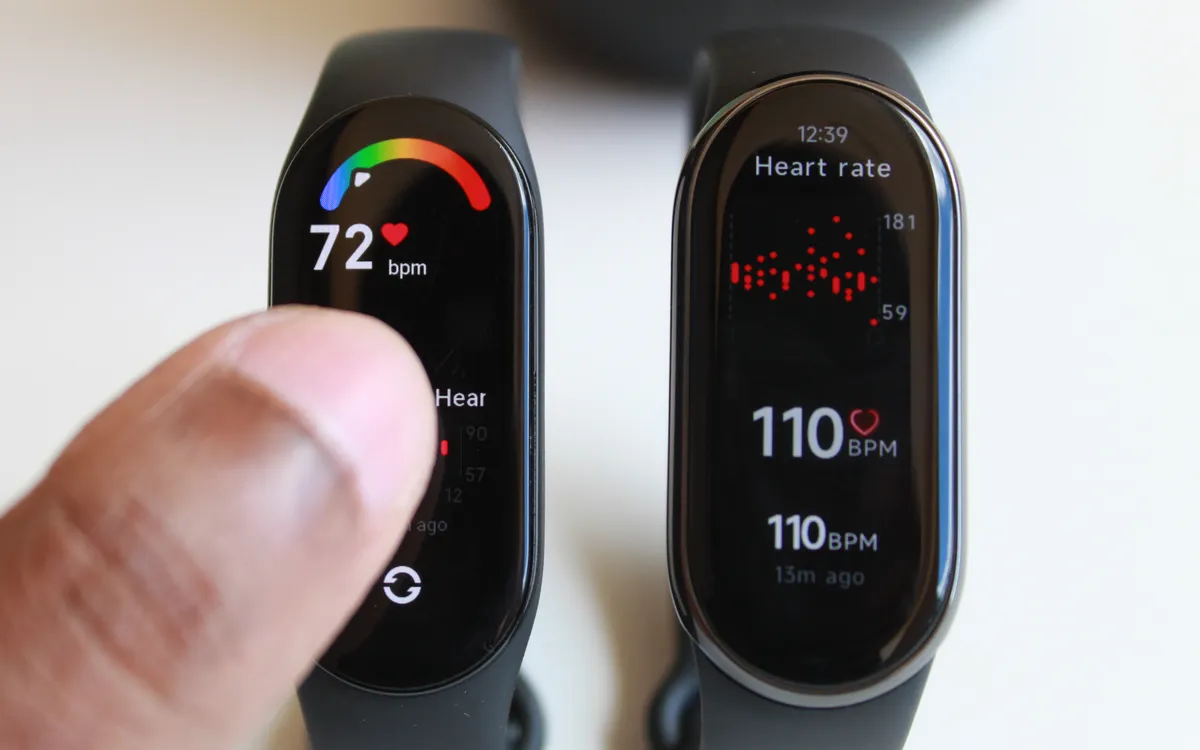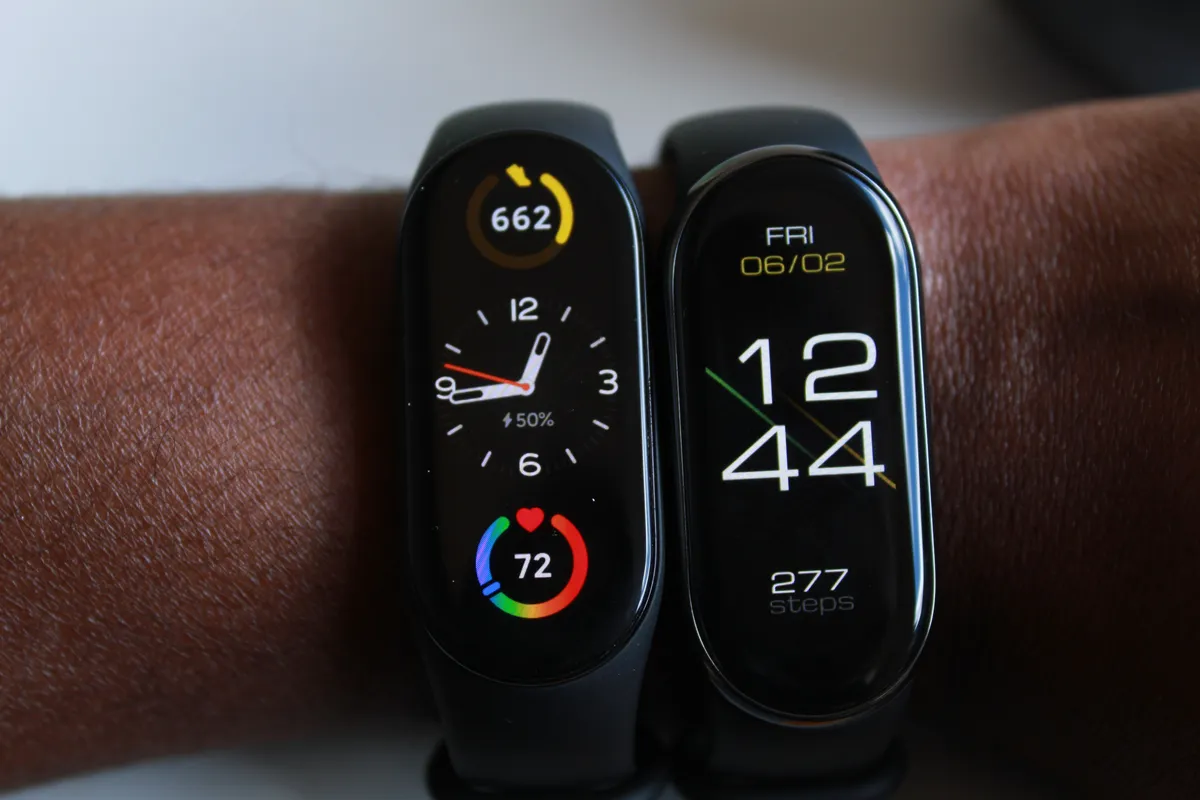On April the 18th 2023, Xiaomi released the new Mi Band 8 for the Chinese market and on the 26th of September 2023 the global version. How does the Mi Band 8 compare to Mi Band 7 released a year ago?
And which one should you choose? Does it make sense to upgrade?
In this blog post, we will answer all of these questions, review the main aspects of these two trackers, such as design, display, battery life, and functionality and give our thoughts on the right band for you.
Let’s get started!
Here is a brief overview of their main similarities and differences.
| Mi Band 7 | Mi Band 8 | |
| Display – Size | 1.62 Inch AMOLED display | 1.62 Inch AMOLED display |
| Resolution | 192 x 490 pixels, 326 PPI, 30Hz Refresh Rate | 192 x 490 pixels, 326 PPI, 60Hz Refresh Rate |
| Brightness | ≥ 500 nits, adjustable | ≥ 600 nits, auto adjustable |
| Body Dimensions | 46.5(H) × 20.9(W) × 12.3(D) mm | 48(H) × 22.5(W) × 11(D) mm |
| Body Net Weight | 13.5g | 14.2g |
| Battery Capacity | 180mAh | 190mAh |
| Sensors | 3 | 4 |
| Processor | Dialog 14706 | ? |
| Wireless connection | Bluetooth 5.2 BLE | Bluetooth 5.1 BLE |
| Supported systems | Android 6.0+, iOS 10.0+ | Android 6.0+, iOS 12.0+ |
| Features | Alarms, notifications, watch faces, widgets, heart rate monitoring, SpO2, sleep tracking, step counting, exercise tracking, menstrual cycle tracking and more customization options | Alarms, notifications, watch faces, widgets, heart rate monitoring, SpO2, sleep tracking, step counting, exercise tracking, menstrual cycle tracking, vitality, and more customization options |
| Fitness Modes | 110+ | 150+ |
| Pricing | Check Pricing on Amazon Check Pricing on AliExpress | Check Pricing on Amazon Check Pricing on AliExpress |
Display and Watch Faces

The display size and resolution are the same for both trackers: a 1.62-inch AMOLED screen with 192 x 490 pixels and 326 ppi. However, the Mi Smart Band 8 has some improvements in brightness and refresh rate. The Mi Band 8 can reach up to 600 nits of peak brightness, compared to the Mi Band 7’s 500 nits.
This means that the screen is more visible in bright sunlight and outdoor conditions. That, and the new light sensor, makes the Mi Band 8 display a real joy in all ambient conditions.
I like it.
The Mi Band 8 also has a 60Hz refresh rate, which should scrolling and animations smoother and more responsive. The Mi Band 7 has a lower refresh rate of around 30Hz. Having use the Mi Band 8 for a month now, I can’t say that I have noticed the display being more responsive than the Mi Band 7. But your experience may vary.
The Mi Band 8 comes with new watch faces. The design of the default watch faces is really good: modern and minimalist. They’ve done away with the functional and cartoonish watch faces on the Mi Band 7.
Yes, this is at the cost of the loss of functionality of Mi Band 7 watch faces. The various features on the Mi Band 8 watch face are no longer clickable – so they don’t act as shortcuts to say weather, steps, or workout features. And you can’t swap them.
I am still getting used to this loss in functionality of the Mi Band 8 watch faces.
Don’t get me wrong, I really like the watch faces on the Mi Band 8, but I really miss the ability to customize my watch faces and simply tap and access feature menus.
All in all, I really like the display on the Mi Band 8. It is better than the display on the Mi Band 7. I really like Mi Band 8 watch faces, but hate the loss of functionality that I’ve had since Mi Band 5.
Design and Strap

The Mi Band 8 and the Mi Band 7 have a similar design, consisting of a pill-shaped module that fits into a silicone strap. However, there are some noticeable changes in the design of the strap on the Mi Band 8.
The Mi Band 8 has a new two-piece strap mechanism that clips into either side of the module, giving it a more modern and elegant look. The Mi Band 7 has a unibody strap that stretches over the module, which is harder to remove and replace.
The Mi Band 7 strap is interchangeable with older Mi Bands, Mi Band 5 and 6, but the Mi Band 8 strap is not interchangeable with other Mi Band models. If you are looking to upgrade from an older Mi Band and reuse your cool replacement strap, you will not be able to do so with the Mi Band 8.
The Mi Band 8 is also slightly longer and wider, but thinner than the Mi Band 7. The dimensions are 48 x 22.5 x 10.99mm for the Mi Band 8 and 46.5 x 20.7 x 12.25mm for the Mi Band 7. Both trackers are lightweight and comfortable to wear. I have noticed the Mi Band 8 does not dig into the skin as much as the Mi Band 7. The underside is smoother on the Mi Band 8.
Another advantage of the Mi Band 8 is that it can be worn in different ways, not just on the wrist. You can attach it to a necklace pendant or a running shoe clip and still track your activity. This gives you more flexibility and versatility in how you use your device.
Charging ports are present at the back of the Mi Band 7 and Mi Band 8. The Mi Band 8 comes with a new charging cable that is not interchangeable with the Mi Band 7 charging cable. Also located at the back of both bands are a 3-axis accelerometer and 3-axis gyroscope and a PPG heart rate sensor.
In my opinion, the design of the Mi Bands is one of the best fitness band design. And they did fulfill one of my wishes and made the Mi Band 8 thinner.
Battery Life and Charging

The Mi Band 8 has a battery capacity of 190mAh, while the Mi Band 7 has a battery capacity of 180mAh. According to Xiaomi, the Mi Band 8 can last up to 16 days with typical use and up to six days with always-on mode enabled.
Mi Band 8 should have a longer battery life than the Mi Band 7.
I have not yet had a chance to extensively test these claims. My initial impression is that the Mi Band 7 has a battery life that is approximately 15% longer than the Mi Band 8.
For instance, right now my Mi Band 8 has 40% charge which is estimated to last me 6 days. On my Mi Band 7, I have 50% charge and it’s estimated that will last more than 9 days. Normally, my usage is somewhere between Typical and Power saving.
I don’t know why the battery life of my Mi Band 8 is shorter than on my Mi Band 7, while the Mi Band has 5% more battery capacity. My guess is that the display on my Mi Band 8 is eating into my battery life; I’ve set the auto brightness feature on the Mi Band 8, and on the Mi Band 7 I’ve manually set the brightness pretty low as I am indoors most of the day.
There could be other reasons for the shorter battery life on the Mi Band 8 as the battery life of Mi Bands does vary depending on the features that are turned on. Or it could be I’m using the Mi Band 8 a lot – shiny new toy syndrome.
Ultimately, there is little difference in the battery life of Mi Band 8 compared to Mi Band 7. And how long it lasts depends on how often you use the features and settings of your device, such as always on display (AOD), SP02 and heart rate monitoring, notifications, etc.
The real difference between the Mi Band 8 and Mi Band 7 is how quickly you can charge them. Xiaomi have halved the charging time to 1 hour on the Mi Band 8 from 2 hours on the Mi Band 7!
Here is a table that summarizes the battery life of Mi Band 7 and Mi Band 8
| USAGE | Mi Band 7 | Mi Band 8 |
| Heavy Use (AOD) | 5 Days | 6 Days |
| Typical Use | 10 Days | 12 Days |
| Power Saving | 14 Days | 16 Days |
| Charging Time | 2 Hours | 1 Hour |
Functionality, Features, and Interface

The biggest differences between Mi Band 7 and Mi Band 8 are in functionality and the interface. Both band come with lots of similar features; step tracker, heart rate monitor, alarm, timer, stopwatch, and a few more – all of these are easy to use.
But, Mi Bands need to be paired first with an app, Mi Fitness or Zepp Life, to work. And the companion apps are the main way to control and customize your Mi Band.
With Mi Band 8, you can only use the Mi Fitness app and Notify for Xiaomi to pair the fitness band to your phone.
You can’t use Zepp or Zepp Life.
The companion apps are the main way to control and customize your Mi Band. One of main selling points of Mi Bands has been the numerous apps that were available to customize and control your smart fitness band.
Personally, I do like the Mi Fitness app over Zepp Life, Notify for Mi Band and other apps. But I really don’t like lack of choice with Mi Band 8.
For instance, there was a bug in the Mi Band 6 firmware on Mi Fitness that depleted your battery within 2 days! The only solution was to either use Notify to revert to an older Firmware or use Zepp Life. And it took 5 months for Xiaomi to fix the bug on Mi Fitness.
Could you imagine if we had a similar issue on the Mi Band 8. We’d have no recourse and that is unacceptable.
So, if you plan to upgrade to or buy the Mi Band 8, keep this limitation in mind. Hopefully more functionality, connecting to Google fit and Strava is top of the list, will be added to the Mi Fitness in the future.
As mentioned earlier, the swap and shortcut functionality of the watch faces has also been removed. Hopefully, we also get this back, via a firmware/OS upgrade in the feature.
Which segues to the new operating system (OS) on the Mi Band 8. Mi Band 8 uses a new Xiaomi proprietary OS, while Mi Band 7 uses Zepp OS. The two OS are very similar – icons are the same and very similar functionality. The only differences I have notices is in the watch faces and the new widgets you get when you scroll to the right or left on the Mi Band 8.
On the subject of accuracy, I have noticed that Mi Band 8 is a more conservative in its approximation of number of steps than the Mi Band 7. Which is a good thing as the Mi Band 7 tends to be a little liberal in its steps approximation.
The sleep tracking is better on the Mi Band 8 than the Mi Band 7; it accurately record when you fall asleep and wake up and deep sleep duration – even without advanced tracking enabled.
Where the Mi Band 8 is off the mark is heart rate monitoring. There is a huge variance in the heart beat per minute (BPM) values it approximates. I have noticed values of 70BPM to 180BPM on a normal day. That’s a huge variance.
Mind you, this is without a workout session. In fact, when I was doing a light workout, the max BPM Mi Band 8 recorded was 108 BPM, while the Mi Band 7 recorded max BPM of 135 during the workout. And the Workout history app on the Mi Band 7 has been renamed Activity on the Mi Band 8.
Finally, Mi Band 8 comes with an ambient light sensor, which is lacking in the Mi Band 7. Functionally, I didn’t think this was a huge deal when I got the Mi Band 8. But, having used the auto brightness feature for a month now, it’s a godsend. It works really well, and I didn’t realize how often I have to increase the brightness on the Mi Band 7 whenever I go outdoors.
Pricing
The Mi Band 8 and Mi Band 7 are both affordable fitness bands, but their prices may vary depending on the online/local store you purchase them from. For the most up-to-date pricing, I recommend checking your favorite online stores, such as Amazon, Aliexpress, and others.
However let me give you an idea of what I’d consider to be decent bargain price for the Mi Band 7 and the Mi Band 8 at your online/local store. $40 is a good price for the Mi Band 7. If you are a budget shopper, the Mi Band 7 is a good choice at these prices. But definitely don’t pay more than $50 for the Mi Band 7.
I’d consider buying the Mi Band 8 at the $50 price, depending on whether it’s the Chinese – usually $5 – $15 cheaper than the global version. The only big difference between the Chinese and Global version is the number of languages supported. The global version supports more languages than the 3 languages (simplified, traditional and English) the Chinese version supports.
Depending on your location and online store, you can get a good deal on the Mi Band 8 CN version – I did find it on Aliexpress for $36. So, shop around. You may find either of these bands at a great price.
Wrap up

Would I recommend the Mi Band 7 over Mi Band 8?
Maybe.
I value function over style.
And, in my opinion, the Mi Band 7 is functionally better than the Mi Band 8. The Mi Band 8 comes out on top in the looks department, and the ambient light sensor is great. But, the user experience is much better on the Mi Band 7.
But, if you are willing to be limited to Mi Fitness (with its limitation) and are ok with the lack of swap and shortcut functionality on the watch faces, then get the Mi Band 8.
For Mi Band 7 owners, should you upgrade to Mi Band 8?
Nope.
Unless your Mi Band 7 is broken. The Mi Band 8 and Mi Band 7 are very similar fitness bands: there is nothing that really sets the Mi Band 8 apart from Mi Band 7.
And even if you need to replace your Mi Band 7, think about replacing it with a Mi Band 7. Especially if the price of a new Mi Band 7 is close to $30 – which it likely will be once the global version of Mi Band 8 hits the market in late June.
That’s it for this post and thank you for reading my blog post! If you have found it useful, let me know in the comments section below. If you have any questions or comments, please leave them below!

Leave a Reply